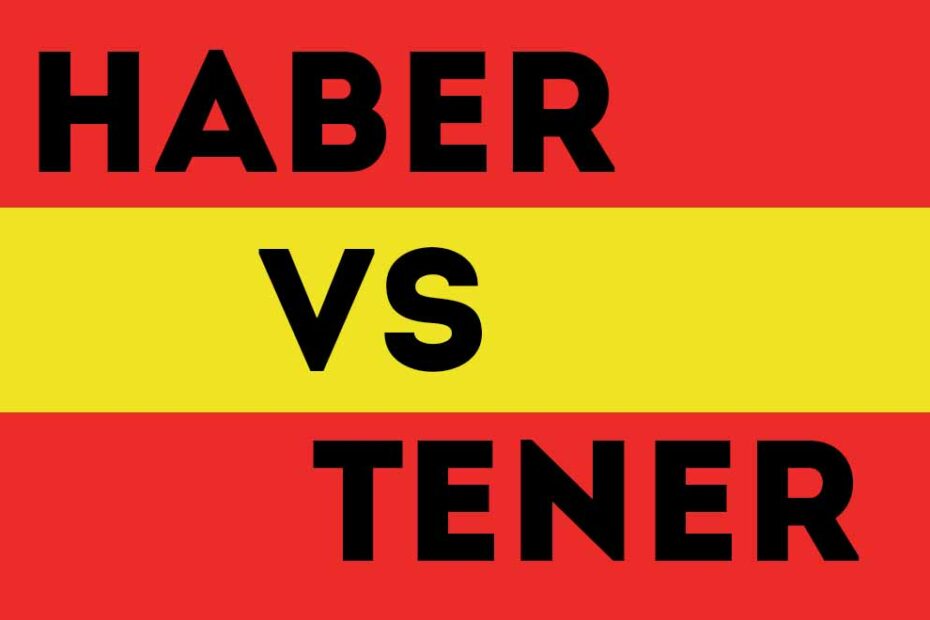Without a doubt, understanding the proper use of the verb “to have” and, more specifically, the distinction between the verbs and the noun tener, are two of the most difficult parts of mastering the Spanish language. There is frequently confusion over which of the two verbs should be used in a given scenario, regardless of whether you are a novice or have been speaking Spanish for some time. In today’s essay, we will attempt to provide a clear and succinct solution to this subject by eliminating all ambiguity. Make a strong start by laying a solid foundation.
Haber vs Tener – When to use haber and when to use tener?
When studying Spanish, it is critical to understand the distinction between the two verbs haber and tener as they are used in different contexts.
The distinction between this two verbs is an important issue for all Spanish language learners to understand.
The primary reason why so many individuals make mistakes when employing the two verbs is that there is only one translation for each in their home language, which makes it difficult to distinguish between the two.
In other words, in some languages, unlike Spanish, there is just one verb that expresses the meanings of the words haber and tener.
To begin, it’s important to know that Haber is typically utilized as an auxiliary verb in the construction of compound tenses of verbs.
Tener, on the other hand, is mostly employed as a possessive verb, which means “to have” or “to possess.” However, there are some situations in which these two verbs are used in a manner that is very similar. For the sake of not becoming perplexed, let us examine when and how they should be utilized together.
Haber vs Tener — When should you use haber?
The three instances in which the verb haber is required are explained below..
Situation # 1
Despite this, we use haber as an auxiliary verb in the production of the compound tenses, as previously stated.
When the haber is followed by a participle, there is no variation in the meaning. In other words, it does not correspond to the subject of the action in terms of gender and numerical value.
Let’s look at some examples:
- He preparado la comida. = I have prepared the food.
- Esta mañana, en la escuela, hemos leído un hermoso poema. = This morning, at school, we read a beautiful poem.
- En tres años Marco habrá obtenido el grado en ingeniería. = In three years Marco will have obtained a degree in engineering.
Situation # 2
In addition, the impersonal form of haber is frequently encountered.
When it comes to existence, the English equivalent would be there is ore there are (present tense), “there will be/there will be” (simple future tense), there was or there were (past tense), and so on.
Even when referring to a plural noun, the verb haber can only be used in the third person singular in impersonal sentences, even when referring to a singular noun.
Additionally, in impersonal sentences, neither the subject nor the personal pronoun may be found.
Now let’s see some examples:
- Hay mucha gente dentro del museo. = There are many people inside the museum.
- Este verano habrá un torneo de baloncesto en la ciudad. =This summer there will be a basketball tournament in town.
- Hay muchas plantas en el jardín de mi abuela. = There are lots of plants in my grandmother’s garden.

— Image by THAM YUAN YUAN from Pixabay
Situation # 3
Finally, haber very often used in verbal periphrases expressing a duty or a requirement. In this case, we use the phrase hay sue.
The word haber is only ever used in the third person singular, just as it was in the preceding example. It is as a result of this that the subject who is expected to carry out the action is not indicated clearly. In this case, the word QUE occurs before the action that needs to be performed.
Let’s see some examples for this third situation as well:
- Hay que cambiar la rueda de mi coche. Se pinchó. = My car tire needs to be replaced. It got a flat tire.
- Hay que respetar las normas. = The rules must be respected.
- Hay que respetar los límites de velocidad al conducir. De lo contrario, es peligroso! = You must respect the speed limits when driving. Otherwise, it is dangerous!
Summarizing
To summarize, then, we can say that haber is used in the following cases:
- As an auxiliary to form other verb tenses (e.g. pretérito perfecto compuesto): yo he comido = I have eaten.
- There is / there are: Hay un gato en la ventana y hay dos perros en la calle. = There is a cat in the window and there are two dogs in the street.
- Form an impersonal periphrasis: Hay que estudiar mucho para aprender. = You have to study a lot to learn.
NOTE
Compound verbs, such as PRETÉRITO PERFECTO COMPUESTO or PRETÉRITO PLUSQUAMPERFECTO, are formed only with the auxiliary haber.
- He ido a la playa. = I went to the beach.
- He comido una pizza. = I ate a pizza.
Haber vs Tener — When should you use tener?
We’ve seen how to use the verb haber; now let’s look at how and when we should use the verb tener instead of the verb haber.
Situation # 1
Tener is a term that is commonly used to describe possession as well as a sensation of being a part of something. There is a gerund after the verb in this sentence, which indicates that it is an object complement.
Let’s see some examples:
- Tengo un libro. = I have a book.
- Mi tío tiene cuatro casas en América. = My uncle has four houses in America.
- Tengo un hermoso bolígrafo. = I have a beautiful pen.
- Tengo una prima muy simpática. = I have a very nice cousin.

— Image by lisa runnels from Pixabay
Situation # 2
We also use the verb tener to express belonging in a figurative sense, feelings, characteristics or physical states, age, etc…
Again, let’s look at some examples to better understand.
Examples:
- Francisco tiene 5 años. = Francisco is 5 years old.
- Gabriela tiene medio de los perros. = Gabriela is afraid of dogs.
Situation # 3
It is possible to indicate an obligation with the verb tener in the same manner that the verb haber is used.
However, unlike verbal peraphrases with the word haber, those with the verb tener do not have an impersonal feel to them like the former.
As a result, it is evident which subject is responsible for carrying out the action.
Examples
- Tengo que llegar al hospital antes de las 8 de la mañana. = I have to be at the hospital before 8:00 a.m.
- Esta mañana tienes que ir a la escuela para el examen. = This morning you must to go to school for the exam.
- ¡Mañana nos vamos de viaje! ¡Tienes que hacer la maleta ya! = Tomorrow we are leaving for the trip! You need to pack your suitcase now!
Situation # 4
It is also possible to find the verb tener in idiomatic idioms, which is another circumstance where it is utilized.
Let’s see some examples of idiomatic expressions:
- Tener frío = to be cold
- Tener hambre = to be hungry
- Tener sueño = to be sleepy
- Tener sed = to be thirsty
Situation # 5
To summarize, there is only one very unique and infrequent circumstance in which the Spanish word tener can be used to serve the function of an auxiliary verb..
It is in this scenario that the person speaking desires to underline that the action to which the sentence relates is being done again and again or expresses irritation with the conduct.
Let’s look at an example:
- Te tengo dicho que no le grites a tu hermana. = I’m telling you (for the umpteenth time) not to yell at your sister.
In some cases, the intention is to express an ongoing situation that has not yet been fully completed.
- Tengo entendido que habrá una huelga. = As far as I know there will be a strike.
Summarizing
We have also analyzed all the situations in which the verb tener is used. Let’s try to briefly summarize everything below:
* Possession: Tengo un bolígrafo= I have a pen
* Age: Cuántos años tienes? Tengo 28 años = How old are you? I am 28 years old
* Obligation (tener que + infinitive): Tengo que estudiar = I must study
* Idiomatic expressions: Tener sed = to be thirsty
* To express annoyance
Conclusion
To conclude we leave you with an example with a Spanish phrase that uses both haber and tener:
Yo tenía una pulsera, pero la he perdido. = I had a bracelet, but I lost it.
It is surely not simple for a native English speaker to understand how to use the verbs haber and tener in the Spanish language (especially when you are first starting to learn Spanish). However, you should not let this deter you from learning the language! You can only master complex grammatical rules via repetition and consistent practice, just like any other skill.
All that remains is for you to put in the time and effort necessary to learn how to effectively employ haber vs tener.
Good luck, and good work!



